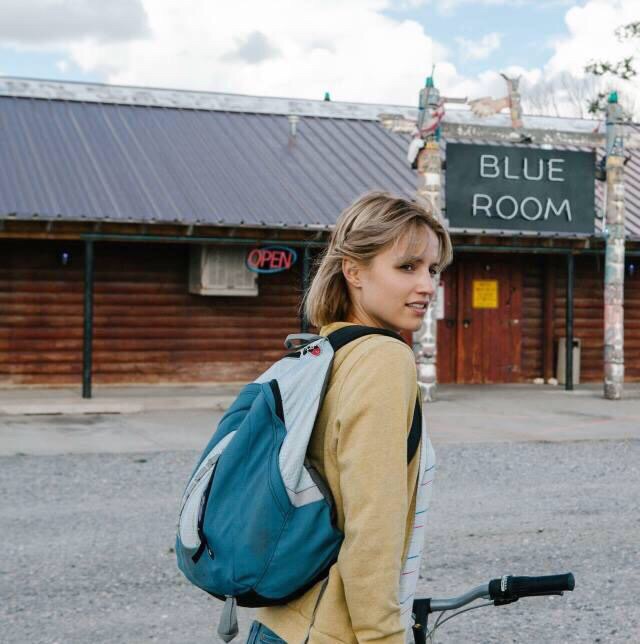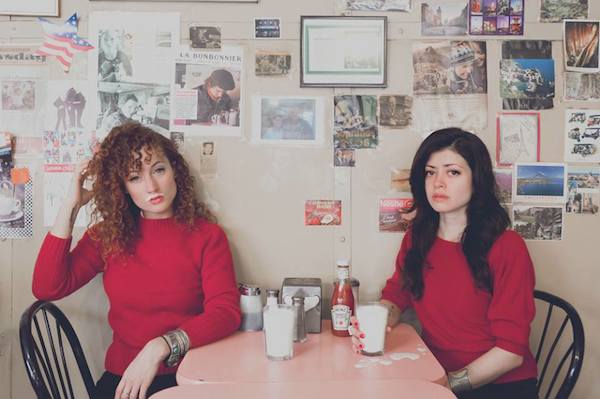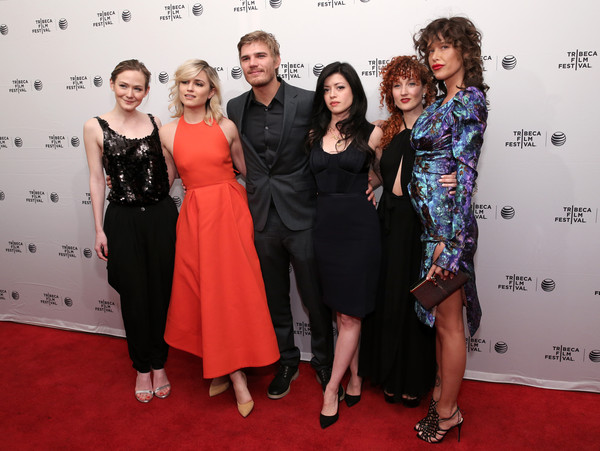Following festival buzz of their sexy and stylish new film starring Dianna Agron and Paz de la Huerta, this talented Brooklyn-based queer duo has cemented themselves as the new faces of future female-driven indie filmmaking.
Featured Image: Dianna Agron and Paz de la Huerta as Sarah and Pepper in BARE. Purple Milk Productions.
Demitra ‘Demi’ Kampakis | Film Editor
As the opening credits of BARE unfold, writer-director Natalia Leite instantly transports us inside the underground allure of a Nevada truck stop strip club. With its whirling array of glossy lights flashing against the pounding beats of club tunes, this space instantly transforms from a seedy nightlife interior into an intoxicating neon oasis rife with temptation, seduction, and the allure of reckless abandon. Juxtaposed against the parched, bleached-out and barren desert landscapes that dominate the daytime, and it becomes clear that Nevada is as integral to this film as its characters—a dynamic presence with as many faces and personalities as the people who reside in it. Indeed, Leite gets potent mileage out of this spatial consciousness, and she effectively uses the vivid, contrasted Nevada tableaux to inform the film’s narrative, as well as enrich its visual tapestry and the world her characters inhabit.
Leite’s film directorial debut stars Dianna Agron as Sarah Barton, a disillusioned Nevada townie who finds herself utterly unfulfilled in every aspect of her life: with a vapid job as a cashier at an equally dismal local supermarket, an estranged father, a depressed mother, maddeningly dull friends, and a boyfriend who doesn’t seem to satisfy her libido or stimulate her mind, Sarah becomes increasingly dejected from both the stifling banality of her life, and her town’s limited worldview and opportunity. Determined to break free from the shackles of conformity and complacency that plague her surroundings, she languidly passes her days in search of something to jolt her out of her fugue state and give her life the purpose and passion she so desperately craves.
That spark soon comes in the form of Pepper (Paz de la Huerta, in her usual air of spacey badass vixen), a sexy drifter whose dodgy yet colorful past, charisma, and spontaneity seem to mystify the more reserved Sarah and ease her existential ennui. Broke and on the run from a mounting debt, Pepper ingratiates herself into Sarah’s mundane existence and introduces her to the hedonistic thrills of sex and drugs, and the insights of spirituality. Entranced by Pepper’s free-spirited nature, Sarah’s curious intrigue quickly develops into a deep, mutual affection, and the two women soon find themselves in the throes of an intense affair. Choosing to no longer be a passive bystander to her own life, our young heroine falls deeper into Pepper’s world, seeking exhilaration and sexual liberation as a stripper while further isolating herself from friends and family.
In an impressive display of stylistic synergy, the film’s cinematography, editing, and art direction come together to inform Sarah’s narrative arc in ways that are visceral and illuminating. Its vibrant visuals and lush vistas beautifully backdrop our hero’s journey to finding her inner tempest—and in one particularly memorable scene involving a peyote-fueled tryst in the desert, Leite plays with the scenery’s natural exoticism to create an atmosphere of sensual mysticism and animalistic carnality, as a nude Sarah frolics in the sand while entwined with a snake. Most remarkable, however, is a brisk edit in the film’s third act, when Sarah, in an act of quiet defiance, decides to finally disengage from her friends’ narrow-minded judgments and petty gossip. Standing up to quietly leave the baby shower she’s attended, she exits the front door and emerges through another in an entirely different location and scene. By preserving the continuity of Sarah’s actions, this seamless editing technique visually mirrors our protagonist’s new found independence. At times, cutting off ties and leaving parts of one’s life in the past comes with the territory of self-assertion, an act of catharsis that Sarah understands to be a necessary evil in claiming agency over her identity and her life, as she walks down the winding road to her unknown future.

Shortly after the film’s premiere at the Tribeca Film Festival, I had the opportunity to sit down with Ms. Leite and co-producer Alexandra Roxo, who plays drug-loving Texan stripper Ginger in the film. Since meeting at a queer party in Brooklyn a few years back, the two Brazilian natives have closely collaborated on multiple projects together including documentaries for VICE and the web series Be Here Nowish, which they co-write and star in under their Purple Milk production company. Given that this talented duo are on the fast track to being the future of female-driven indie filmmaking, I was eager to pick their brains on the creative process of filming, feminism and spirituality, and what it’s like to be on the same artistic wavelength.
How did you get on board with this film?
Natalia: This is the first feature film I wrote, and I went through a million revisions and renditions of the script. I came from a visual arts background and had studied photography and performance before I decided to get into film. Even though Bare isn’t autobiographical, the script is definitely inspired by relationships and events in my life—more an allegory, if you will. And when I met Alexandra, I shared the script with her. After being cast aside by many producers, finally we went ahead and decided “let’s do it!”
Alexandra: Natalia and I had been working together for a while by the time this project truly took off, and at the time we met, we were both working on our own feature scripts. I read an early draft of Bare, and she read my script for Mary Marie, and we gave each other feedback while also beginning to collaborate on other projects together. Finally, after some frustrating delays, we just pushed forward with this film. It was very challenging, but very rewarding.
How is feature film different from music video, documentary, fashion films or web-series formats, for which you have prior experience?
N: I definitely think I use similar themes in all my work, so it’s consistent in that way. Be Here Nowish is a collaboration effort with Alexandra, and with music videos you also work closely with others—so there’s other creative voices as well. Web series allow you to be a bit more free form, whereas with feature films, structure becomes so much more important, and you have to be really tight as a whole since scenes do get cut.
A: For Natalia and I, dabbling in various projects has allowed us to build our brand, and fortunately our work and themes have come to us rather than us seeking it out. But it’s really more about the material itself and the heart of our work, rather than a particular awareness of the medium used.

Though it does have its darkly funny moments, Bare is certainly a more serious film, as was Marie Mary—whereas Be Here Nowish is a comedy. Is it easier to utilize humor, or work with the conventions of drama?
N: I think it’s sort of easier to do comedy, because there’s a fine line with drama—people have to be really invested for it to work, while comedy can still be fun and entertaining even if you’re not necessarily as invested in the characters. But with drama you REALLY have to feel something, you know, so that’s definitely more of a challenge. Even with this film it was important to include some comedic moments caused by the simple awkwardness of the two characters coming together, and the satire of it.
A: A lot of the comedy in Be Here Nowish is taken from our own lives and the ridiculous, hilarious situations we encounter in real life. Yet the story of Bare didn’t lend itself to that—it’s more about a particular moment in someone’s life. The same goes for Mary Marie, which explores the boundaries between female friendship and romance. The cool thing about our collaboration is that we have been able to do different things and experiment with multiple genres—it’s such a bummer when a director has to strictly choose because at the end of the day, our lives are full of drama, comedy, and tragedy—so why should we be forced to stick to one thing?
This film assumes a very sex-positive outlook, and Ginger particularly embodies that sexualized female empowerment. Would you consider your work to be feminist?
N: That’s a good question, and that really depends on how people define feminism because I think that word has taken on so many definitions through the decades, and for me I would say I don’t like to put that label because it can be misinterpreted. It’s all about the story and not necessarily about a specific message we’re going after, you know? But of course I want to do what empowers women because I want women to feel empowered—that’s important in society, so if that is feminism then yes, I would say so. At the same time, I also think that we haven’t seen Paz in a role quite like this, where she’s not using her sexuality to get what she wants—she has to be able to manipulate situations and be magnetic and attractive in other ways. And even for the character of Sarah, I think that by her working in a strip club, she’s being more real and true to herself, so I think that in terms of creating multi-faceted roles for women, my work reflects that part of feminism.
A: The word ‘feminist’ has changed and lived in so many different iterations, and I think that I have definitely called myself a feminist since I was young—I just find the current iteration of it to be a little bit problematic, so I think Natalia and I both don’t necessarily identify with that current language as is. We prefer to just tell strong stories and have great characters going through real problems and real emotions. At the end of the day, that’s more important than whether or not our work has a feminist agenda, because we’re just making work that we love—and if it happens to be sort of provocative in that way, then cool. Once while on location at the strip club featured in Bare for an episode of VICE, we had some people preaching to us that we were too feminist, while others were saying we weren’t feminist enough. I remember thinking “wow, this is a really interesting conversation to have”—but at the same time you can’t please everyone, so we instead want our work to shed light on individual subjective experiences that are isolated from any larger agenda.
There was a stark contrast in the film between the love scene depictions involving Sarah and her boyfriend, and those with Sarah and Pepper. How did you approach each?
N: Well, I see that in the beginning Sarah is with this boyfriend, and maybe there’s not a lot of passion in her life, and that carries out in her relationship. It’s not that she doesn’t like him or doesn’t want to be with him, but that she is just lacking passion in her life as a whole. And Pepper is someone who is very alive, and very interesting—almost like an alien in her town—so the relationship with them becomes more about how different and intriguing this is for Sarah, rather than it mattering whether she’s with a man or a woman. The love scene with Pepper, then, had to be this sexual awakening for Sarah, she had to feel like she was really ripping off a layer of herself—which I wanted to relay through that really deep orgasm—while images of Paz in the desert are being intercut. This light is flaring on her, and as Sarah is consumed by euphoria, Paz becomes sort of this animal instinct.
Speaking of, there’s a very animalistic—but also humanistic—balance in the film. Like Be Here Nowish, sexual fluidity seems to be at the forefront and isn’t necessarily defined through any labels, or even directly addressed. Is that ambiguity an important factor in your work?
N: Yeah, it’s present in all the work that I’m creating or what I’m attempting to do because I think, Sarah is in a box, so she’s not going to leave one box to go into another box. She’s not going to say, ‘Oh, you know what? I think I’m gay,’ or ‘I think I’m bisexual.’ That’s all that matters. It’s not a story of her figuring out what other box she fits into, but rather just being able to get past those labels. I think their emotional connection is more unique to their circumstance than it is reflective of a greater ‘lesbian dynamic’ because this particular story is about this character being totally raw and vulnerable with another person, who just happens to be a woman.
The film makes many symbolic associations between the desert and bodies of water. It’s an effective visual metaphor for the mysteries that lie within the ocean’s abyss, which can be scary but also exotic and hopeful—as opposed to the disillusionment and emptiness conveyed by the arid desert, the sense of wasted potential and being dried up and withered away. Can you elaborate on that duality?
N: There were a lot of visual metaphors that we were working with. Like you pointed out, Sarah wants to be part of another world, and that is certainly woven into the film; where we see Sarah swimming on the floor of the supermarket as part of a daydream, Pepper talking about how octopuses are her spirit animals, and finally as the two are swimming in a pool together amidst the blue light that bathes them, which translates Sarah’s desire to completely immerse herself in this other world. So thank you for noticing that [chuckles].
Of course! While we’re on the topic of visual metaphors, there is a great symmetry in the way the cinematography alternates between the saturated color schemes of the club and nightlife scenes, and the more muted hues of the outdoor desert. Had you known early on that you would use this visual dichotomy?
N: After mapping out a bunch of reference images with our DP Tobias Dayton and our production designer Lisa Myers, we agreed that Sarah’s world and her town should be very monochromatic and more starkly flat. Whereas for the club the intention wasn’t necessarily seedy, but more alluring and sexy and almost confusing because it’s a little psychedelic, so when we did our color session for the film we totally bumped up those colors to make them more intense. Certainly this club wouldn’t exist in real life, but that’s exactly what we were going for.
Almost like a fantasy—which relates to the film’s overall flirtation with mysticism and references to spirituality, not to mention two ethereal and surreal fantasy sequences.
N: Exactly, as a way to emphasize that this story is through Sarah’s point of view—we are seeing and experiencing what Sarah is seeing and experiencing.
Any upcoming solo or collaborative projects in the works?
A: Natalia and I just shot and are currently editing season 2 of Be Here Nowish, which has deeper and fuller character arcs than season 1. We tried writing it as close as possible to how it would be written for television since that’s our ultimate goal—so there’s actually a bit of drama this season in addition to the comedy. It’s a little nerve-wracking since we’re taking greater risks this time, but I’m excited. We’re also thinking about writing a script for a thriller together which should be very interesting, and solo-wise, I just finished working on 4 episodes for The Knick’s upcoming season—so I can’t wait to see how it all comes together!

